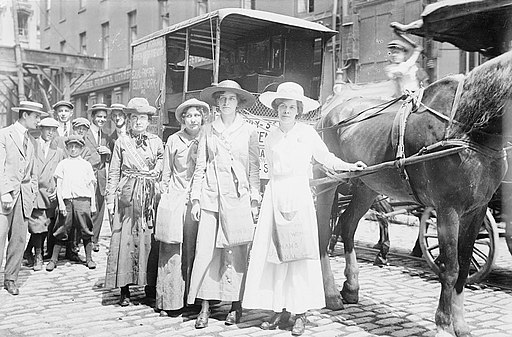
How Immigrant Women and the Labor Movement Helped Pave the Way for Equal Pay
Image Source: https://commons.wikimedia.org/w/index.php?curid=27547988
It may seem hard to believe, but even in 2021, a pay gap exists between male and female workers, in virtually every industry on Earth. As of March 24, known as Equal Pay Day, for every dollar earned by a white male, women earn 81 cents on average. The gap is even wider for minority women, with Black and Hispanic females bringing in 63 cents and 55 cents on the dollar, respectively.
That such a disparity persists despite federal laws that prohibit it has spawned calls for action. Numerous female athletes have become increasingly vocal in regards to the call for equal pay in recent years. But average citizens within the national workforce are also speaking out, especially immigrant and minority women. Since the early days of the fight for equal pay, immigrant women have been a vital part of the movement.
In early-1900s New York City, for instance, thousands of Jewish immigrants in the garment district went on strike, demanding better working conditions and fair pay. At the time, it was the largest strike ever organized by female workers in the U.S. and was highly successful. Fast forward to modern times, and a similar movement can be seen among migrant farmworkers, bolstered by working-class immigrant women.
The work and advocacy of female immigrants cannot be understated when it comes to labor protection for women, in every industry, regardless of race and/or socioeconomic status. Let’s take a look at how scores of brave women have helped pave the way towards equal pay and greater protection for America’s female workers.
The True Cost of “Equal” Pay: by the Numbers
Although the call for equal pay for equal work pre-dates the Equal Pay Act of 1963 (EPA) by a substantial margin, the bill helped bring about widespread attention to women’s issues. In theory, the EPA protects workers from wage discrimination based on sex, as long as the workers in question are performing jobs deemed “substantially equal.” Yet that’s not the entire story, and wage-based discrimination persists into the present day.
The EPA is a federal bill, but many states have adopted their own versions of the mandate, effectively adapting to the times. Similar to how the historic law of coverture, wherein a married woman was legally considered her husband’s property, fell out of favor over time, so did the concept of inequality in pay. As recently as January 2021, Colorado’s Equal Pay for Equal Work Act finally went into effect, bringing greater accountability to employers across the state.
With the enactment of its equal pay act, Colorado became the 49th state to adopt similar legislation. The U.S. territory of Puerto Rico also enforces equal pay laws, and Mississippi is the only state that has opted out in terms of equal pay. Yet, as previously mentioned, women in the labor force still make less money on average than their white male co-workers, despite state and federal laws prohibiting wage discrimination. And immigrant workers are disproportionately affected.
Regarding America’s Immigrant Workers
“America was built on the backs of immigrants” is more than just a catchy phrase used by activists in the fight for equal pay; a similar sentiment has been shared by several former presidents, including George H.W. Bush, who once declared that immigration is both a link to our nation’s past as well as a bridge to the future. Further, one of only three books penned by John F. Kennedy (published posthumously in 1964) focused on the importance of immigration under the title, “A Nation of Immigrants.”
Despite the crucial role of immigrants in the founding and construction of America, however, immigrant workers in modern times are facing an uphill battle. Immigration laws can be confusing, as there are numerous forms of work permits available to immigrants. Migrant farmworkers, who make up a large chunk of the U.S. immigrant labor force, must obtain an H-2A visa to legally work in the country, even temporarily.
Unfortunately, having the correct visa in hand doesn’t mean that immigrant workers will receive fair pay or equal treatment from their employers. Many times, immigrant workers must band together and speak out against unfair labor practices or unequal pay, and it helps if those workers possess leadership skills.
The Importance of Women in Leadership Roles
Historically, the fight for equal pay has been a collective effort of women from all walks of life, but strong leadership was also crucial to the cause. Labor union leader Rose Schneiderman, for example, is still regarded as “a capable organizer, public speaker and leader.” Schneiderman’s efforts helped bring about a national minimum wage, as well as the 8-hour workday that has become standard.
And Schneiderman is far from an outlier in regards to taking a stand and fighting for equality. There’s plenty of research indicating that, as a whole, women make great leaders. For starters, females possess myriad traits that are intrinsically linked to effective leadership. When compared to their male counterparts, female leaders excel at taking initiative, inspiring others to achieve greatness, building relationships, and more.
Women are also keen observers, possessing the ability to see the big picture and act accordingly for the benefit of both the company and the workforce as a whole. In regards to the fight for equal pay, strong leadership can make all the difference. Whether working in America’s agricultural fields or inside a commanding office building, women hold the key to ensuring that equal pay for equal work finally comes to fruition.




